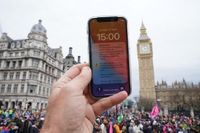Londoners are facing a surge in mobile phone thefts, with new figures revealing that more than 116,000 devices were stolen in the capital during 2024—a record-breaking number that translates to 320 phones snatched every single day. According to statistics obtained by the campaign group Crush Crime through Freedom of Information requests, the Metropolitan Police recorded 116,656 mobile thefts last year, a figure that dwarfs previous records and marks an increase of over 50 percent from 2017, when just over 77,000 thefts were logged.
To put the scale of the problem into perspective, that’s 13 phones stolen every hour, or one every four and a half minutes. And the trend shows no sign of slowing down. In January 2025 alone, police received reports of 8,588 stolen handsets. The year-on-year rise is stark—there were 1,300 more incidents in 2024 than the previous year, which itself had already surpassed pre-pandemic levels.
Despite the staggering number of thefts, the odds of seeing justice served are slim. Only 169 suspects were charged in 2024, and just seven received a caution, according to the Metropolitan Police data cited by the Daily Mail and Evening Standard. That’s a prosecution rate so low it’s almost hard to believe, especially given the sheer volume of crime. The numbers have prompted campaigners and victims alike to question whether enough is being done to tackle what many are now calling an epidemic.
Dr Lawrence Newport, founder of Crush Crime, minced no words in his assessment. “We are in the midst of a phone theft epidemic, and our government is failing to act,” he told reporters. “Our politicians need to wake up to reality: they need to stop this epidemic, and push our justice system to catch, convict and imprison these career criminals. Half of all crime is committed by just 10 percent of offenders, meaning only a small number of career criminals are committing most phone thefts.”
The demographic data paints a vivid picture of the impact. Of the 116,656 victims last year, 61,000 were female and just under 48,000 were male. The gender of the remaining 7,000 victims was not recorded. The financial toll is equally sobering. From 2017 to 2024, nearly 684,000 mobile phones were reported stolen in London, with a total estimated value of £365 million, based on figures provided by victims to the police.
The types of phones targeted are also telling. Apple iPhones were by far the most commonly stolen devices in 2024, with just under 71,000 reported missing, followed by Samsung phones, with 14,000 snatched. It’s a clear sign that thieves are going after high-value, high-demand handsets—devices that can be quickly resold or shipped abroad.
Patterns in the timing and location of thefts have also emerged. The risk of having a phone stolen spikes in the late afternoon and early evening. For example, last year saw 8,231 thefts between 4pm and 5pm, 8,806 between 5pm and 6pm, and a peak of 8,975 between 6pm and 7pm. In contrast, the early morning hours are comparatively safer, with just 1,036 thefts reported between 6am and 7am throughout the year.
Geographically, certain boroughs stand out as hot spots. Westminster led the pack in 2024, with 34,039 phone thefts, followed by Camden with 10,907 and Southwark with 7,316. These areas, often bustling with tourists and commuters, seem to offer rich pickings for opportunistic thieves.
The rise in thefts has not gone unnoticed by the business community. Retailer Curry’s launched a campaign earlier this month to warn Londoners of the risk, while signage across the city now cautions pedestrians about the danger posed by mobile phone snatchers. The message is clear: vigilance is more important than ever.
But why has the problem become so acute? The data shows that phone thefts had already climbed to 91,000 in 2019, only to dip during the Covid-19 lockdowns when streets were emptier and travel was restricted. Yet as life returned to normal, so too did the criminals. By 2023, thefts had bounced back to over 115,000—a figure that was quickly eclipsed in 2024.
Experts suggest that the low rate of prosecutions may be fueling the crisis. With just 169 suspects charged out of over 116,000 thefts, would-be thieves may feel emboldened, calculating that the risk of getting caught is minimal. “The justice system is not keeping pace with the scale of the problem,” said Dr Newport. “If only a handful of offenders are ever brought to justice, it sends the wrong message.”
Campaigners are now calling for a multi-pronged response. This includes tougher enforcement, greater use of technology to track and recover stolen devices, and more robust penalties for repeat offenders. There’s also a push for manufacturers and network providers to do more—such as improving device security and making it harder for stolen phones to be reactivated or resold.
The wider impact of the theft epidemic is hard to ignore. For many Londoners, a stolen phone isn’t just an inconvenience; it’s a loss of vital contacts, cherished photos, and access to banking, transport, and work. The psychological toll can be just as great as the financial one. “It shakes your sense of safety,” said one victim, who asked not to be named. “You start to look over your shoulder, even in broad daylight.”
The authorities, for their part, insist they are taking the problem seriously. Yet with the numbers continuing to rise, many residents wonder whether enough is being done. As Dr Newport and others have pointed out, addressing the epidemic will require more than just words—it will take coordinated action from police, politicians, businesses, and the public alike.
For now, the advice to Londoners is to stay vigilant, keep devices out of sight in crowded areas, and report any thefts immediately. But as the city grapples with this unprecedented wave of crime, many are left hoping for a solution that goes beyond personal caution and tackles the root causes head-on.
With mobile phone thefts at an all-time high and prosecution rates at historic lows, London faces a challenge that strikes at the heart of everyday life. The numbers may be shocking, but for the thousands affected each year, the impact is all too real.




